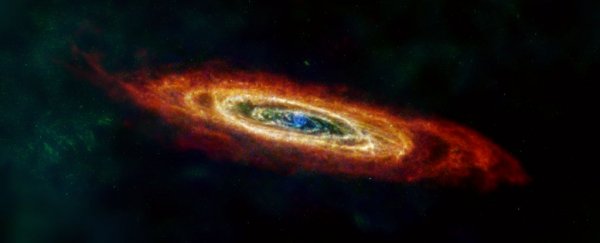When we see pictures of galaxies outside the Milky Way, what we're usually looking at is primarily the light of their stars. But stars are far from the only ingredient that makes up a galaxy. Think of stars as the chunks of vegetables in the galactic soup.
The broth, then, in which they float, is the intergalactic medium – not empty space but filled with often tenuous, sometimes dense clouds of dust and gas that drift between the stars. Because stars are so much brighter, the dust is usually second fiddle; but that dust, from which stars are born, to which stars return, can tell us a lot about the structure and activity within a galaxy.
Now, four new images have been released, showing the distribution of dust in four of the galaxies that are closest to the Milky Way: the Large and Small Magellanic Clouds, dwarf galaxies orbiting our own; the Andromeda galaxy, a large spiral galaxy at a distance of 2.5 million light-years; and the Triangulum galaxy, a spiral galaxy 2.73 million light-years away.
 The Large Magellanic Cloud. (ESA, NASA, NASA-JPL, Caltech, Christopher Clark/STScI, S. Kim/Sejong University, T. Wong/UIUC)
The Large Magellanic Cloud. (ESA, NASA, NASA-JPL, Caltech, Christopher Clark/STScI, S. Kim/Sejong University, T. Wong/UIUC)
Without dust and gas, galaxies as we know them wouldn't exist. Stars form when a dense knot of material in a cold cloud of molecular gas collapses under gravity, incorporating material from the cloud around it. When that star dies, it ejects its outer material back into the space around it, with the new, heavier elements it fused during its lifetime.
New stars being born incorporate the dust from dead stars, making each subsequent generation of stars slightly different. We are, indeed, all made of star stuff – even the stars.
But the dust isn't uniformly distributed. Stellar winds, galactic winds, and the effects of gravity can all push and sculpt interstellar dust into complex shapes filled with cavities. Mapping the structures and the composition of the elements within them is a crucial tool for understanding the formation of… well… pretty much everything.
The new images, unveiled at the 240th meeting of the American Astronomical Society, were obtained by the Herschel Space Observatory operated by the European Space Agency between 2009 and 2013. Until the launch of Webb – which has yet to deliver its first science images – Herschel was the largest infrared telescope ever to be launched.
 The Small Magellanic Cloud. (ESA, NASA, NASA-JPL, Caltech, Christopher Clark/STScI, S. Stanimirovic/UW-Madison, N. Mizuno/Nagoya University)
The Small Magellanic Cloud. (ESA, NASA, NASA-JPL, Caltech, Christopher Clark/STScI, S. Stanimirovic/UW-Madison, N. Mizuno/Nagoya University)
Like Webb, its ultracold operating temperature meant that Herschel could peer into the far-infrared, imaging some of the coldest and dustiest objects in space, down to temperatures around -270 degrees Celsius (-454 degrees Fahrenheit). This includes the cold clouds in which stars are born and the dust in interstellar space.
It was less adept at detecting more diffuse dust and gas, however. To fill in the gaps, a team of astronomers led by Christopher Clark of the Space Telescope Science Institute used data from three other retired telescopes: ESA's Planck and NASA's Infrared Astronomical Satellite (IRAS) and Cosmic Background Explorer (COBE).
The results reveal complex interplays within the dust. Hydrogen gas appears in red; that's the most abundant element in the Universe, so there's rather a lot of it. Cavities in the dust where newborn stars have blown it away with their intense winds appear as empty regions, surrounded by a green glow that indicates cold dust. Blue regions represent warmer dust, heated by stars or other processes.
 The Triangulum Galaxy. (ESA, NASA, NASA-JPL, Caltech, Christopher Clark/STScI, E. Koch/University of Alberta, C. Druard/University of Bordeaux)
The Triangulum Galaxy. (ESA, NASA, NASA-JPL, Caltech, Christopher Clark/STScI, E. Koch/University of Alberta, C. Druard/University of Bordeaux)
The images also reveal new information about the complex interactions that occur in interstellar dust, the researchers said. Heavy elements such as oxygen, carbon, and iron can often stick to dust grains; in the very densest clouds, most elements are bound to dust, increasing the dust-to-gas ratio. This can affect the way light is absorbed and re-emitted by dust.
However, violent processes, such as star birth, or supernovae, can release radiation that breaks apart the dust, releasing the heavy elements back into gaseous clouds. This tips the dust-to-gas ratio back towards gas.
The Herschel images reveal that ratios can vary by up to a factor of 20 in a galaxy. That's much higher than astronomers thought, important information that may help scientists better understand this cycle.
And, they're just spectacularly pretty. Who knew that Andromeda soup could be such a dazzling rainbow of color.
